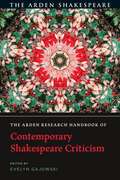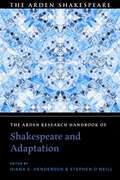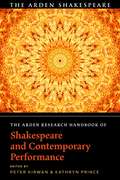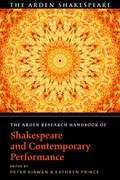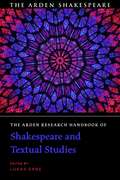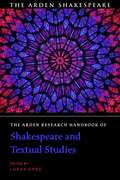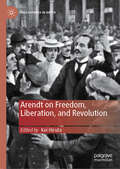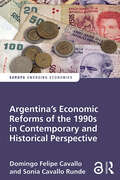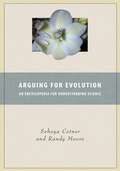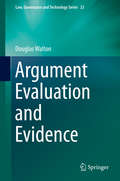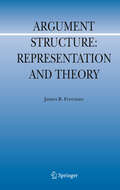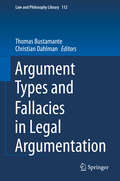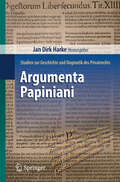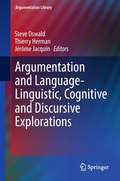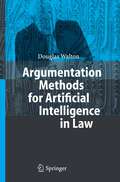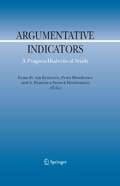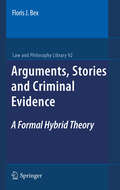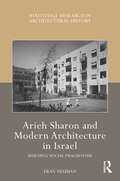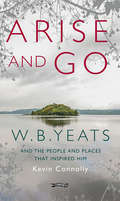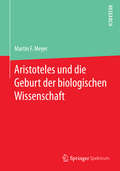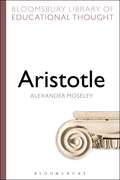- Table View
- List View
The Arden Research Handbook of Contemporary Shakespeare Criticism (The Arden Shakespeare Handbooks)
by Evelyn GajowskiThe Arden Research Handbook of Contemporary Shakespeare Criticism is a wide-ranging, authoritative guide to research on critical approaches to Shakespeare by an international team of leading scholars. It contains chapters on 20 specific critical practices, each grounded in analysis of a Shakespeare play. These practices range from foundational approaches including character studies, close reading and genre studies, through those that emerged in the 1970s and 1980s that challenged the preconceptions on which traditional liberal humanism is based, including feminism, cultural materialism and new historicism. Perspectives drawn from postcolonial, queer studies and critical race studies, besides more recent critical practices including presentism, ecofeminism and cognitive ethology all receive detailed treatment.In addition to its coverage of distinct critical approaches, the handbook contains various sections that provide non-specialists with practical help: an A–Z glossary of key terms and concepts, a chronology of major publications and events, an introduction to resources for study of the field and a substantial annotated bibliography.
The Arden Research Handbook of Shakespeare and Adaptation (The Arden Shakespeare Handbooks)
by Diana E. Henderson and Stephen O’NeillThe Arden Research Handbook of Shakespeare and Adaptation explores the dynamics of adapted Shakespeare across a range of literary genres and new media forms. This comprehensive reference and research resource maps the field of Shakespeare adaptation studies, identifying theories of adaptation, their application in practice and the methodologies that underpin them. It investigates current research and points towards future lines of enquiry for students, researchers and creative practitioners of Shakespeare adaptation. The opening section on research methods and problems considers definitions and theories of Shakespeare adaptation and emphasises how Shakespeare is both adaptor and adapted.A central section develops these theoretical concerns through a series of case studies that move across a range of genres, media forms and cultures to ask not only how Shakespeare is variously transfigured, hybridised and valorised through adaptational play, but also how adaptations produce interpretive communities, and within these potentially new literacies, modes of engagement and sensory pleasures. The volume's third section provides the reader with uniquely detailed insights into creative adaptation, with writers and practice-based researchers reflecting on their close collaborations with Shakespeare's works as an aesthetic, ethical and political encounter. The Handbook further establishes the conceptual parameters of the field through detailed, practical resources that will aid the specialist and non-specialist reader alike, including a guide to research resources and an annotated bibliography.
The Arden Research Handbook of Shakespeare and Adaptation (The Arden Shakespeare Handbooks)
The Arden Research Handbook of Shakespeare and Adaptation explores the dynamics of adapted Shakespeare across a range of literary genres and new media forms. This comprehensive reference and research resource maps the field of Shakespeare adaptation studies, identifying theories of adaptation, their application in practice and the methodologies that underpin them. It investigates current research and points towards future lines of enquiry for students, researchers and creative practitioners of Shakespeare adaptation. The opening section on research methods and problems considers definitions and theories of Shakespeare adaptation and emphasises how Shakespeare is both adaptor and adapted.A central section develops these theoretical concerns through a series of case studies that move across a range of genres, media forms and cultures to ask not only how Shakespeare is variously transfigured, hybridised and valorised through adaptational play, but also how adaptations produce interpretive communities, and within these potentially new literacies, modes of engagement and sensory pleasures. The volume's third section provides the reader with uniquely detailed insights into creative adaptation, with writers and practice-based researchers reflecting on their close collaborations with Shakespeare's works as an aesthetic, ethical and political encounter. The Handbook further establishes the conceptual parameters of the field through detailed, practical resources that will aid the specialist and non-specialist reader alike, including a guide to research resources and an annotated bibliography.
The Arden Research Handbook of Shakespeare and Contemporary Performance (The Arden Shakespeare Handbooks)
by Peter Kirwan and Kathryn PrinceThe Arden Research Handbook of Shakespeare and Contemporary Performance is a wide-ranging, authoritative guide to research on Shakespeare and performance studies by an international team of leading scholars. It contains chapters on the key methods and questions surrounding the performance event, the audience, and the archive – the primary sources on which performance studies draws. It identifies the recurring trends and fruitful lines of inquiry that are generating the most urgent work in the field, but also contextualises these within the histories and methods on which researchers build. A central section of research-focused essays offers case studies of present areas of enquiry, from new approaches to space, bodies and language to work on the technologies of remediation and original practices, from consideration of fandoms and the cultural capital invested in Shakespeare and his contemporaries to political and ethical interventions in performance practice. A distinctive feature of the volume is a curated section focusing on practitioners, in which leading directors, writers, actors, producers, and other theatre professionals comment on Shakespeare in performance and what they see as the key areas, challenges and provocations for researchers to explore.In addition, the Handbook contains various sections that provide non-specialists with practical help: an A-Z of key terms and concepts, a guide to research methods and problems, a chronology of major publications and events, an introduction to resources for study of the field, and a substantial annotated bibliography. The Arden Research Handbook of Shakespeare and Contemporary Performance is a reference work aimed at advanced undergraduate and graduate students as well as scholars and libraries, a guide to beginning or developing research in the field, and an essential companion for all those interested in Shakespeare and performance.
The Arden Research Handbook of Shakespeare and Contemporary Performance (The Arden Shakespeare Handbooks)
The Arden Research Handbook of Shakespeare and Contemporary Performance is a wide-ranging, authoritative guide to research on Shakespeare and performance studies by an international team of leading scholars. It contains chapters on the key methods and questions surrounding the performance event, the audience, and the archive – the primary sources on which performance studies draws. It identifies the recurring trends and fruitful lines of inquiry that are generating the most urgent work in the field, but also contextualises these within the histories and methods on which researchers build. A central section of research-focused essays offers case studies of present areas of enquiry, from new approaches to space, bodies and language to work on the technologies of remediation and original practices, from consideration of fandoms and the cultural capital invested in Shakespeare and his contemporaries to political and ethical interventions in performance practice. A distinctive feature of the volume is a curated section focusing on practitioners, in which leading directors, writers, actors, producers, and other theatre professionals comment on Shakespeare in performance and what they see as the key areas, challenges and provocations for researchers to explore.In addition, the Handbook contains various sections that provide non-specialists with practical help: an A-Z of key terms and concepts, a guide to research methods and problems, a chronology of major publications and events, an introduction to resources for study of the field, and a substantial annotated bibliography. The Arden Research Handbook of Shakespeare and Contemporary Performance is a reference work aimed at advanced undergraduate and graduate students as well as scholars and libraries, a guide to beginning or developing research in the field, and an essential companion for all those interested in Shakespeare and performance.
The Arden Research Handbook of Shakespeare and Textual Studies (The Arden Shakespeare Handbooks)
by Lukas ErneThe Arden Research Handbook of Shakespeare and Textual Studies is a wide-ranging, authoritative guide to research on Shakespeare and textual studies by an international team of leading scholars. It contains chapters on all the major areas of current research, notably the Shakespeare manuscripts; the printed text and paratext in Shakespeare's early playbooks and poetry books; Shakespeare's place in the early modern book trade; Shakespeare's early readers, users, and collectors; the constitution and evolution of the Shakespeare canon from the sixteenth to the twenty-first century; Shakespeare's editors from the eighteenth to the twenty-first century; and the modern editorial reproduction of Shakespeare. The Handbook also devotes separate chapters to new directions and developments in research in the field, specifically in the areas of digital editing and of authorship attribution methodologies. In addition, the Companion contains various sections that provide non-specialists with practical help: an A-Z of key terms and concepts, a guide to research methods and problems, a chronology of major publications and events, an introduction to resources for study of the field, and a substantial annotated bibliography. The Arden Research Handbook of Shakespeare and Textual Studies is a reference work aimed at advanced undergraduate and graduate students as well as scholars and libraries, a guide to beginning or developing research in the field, an essential companion for all those interested in Shakespeare and textual studies.
The Arden Research Handbook of Shakespeare and Textual Studies (The Arden Shakespeare Handbooks)
The Arden Research Handbook of Shakespeare and Textual Studies is a wide-ranging, authoritative guide to research on Shakespeare and textual studies by an international team of leading scholars. It contains chapters on all the major areas of current research, notably the Shakespeare manuscripts; the printed text and paratext in Shakespeare's early playbooks and poetry books; Shakespeare's place in the early modern book trade; Shakespeare's early readers, users, and collectors; the constitution and evolution of the Shakespeare canon from the sixteenth to the twenty-first century; Shakespeare's editors from the eighteenth to the twenty-first century; and the modern editorial reproduction of Shakespeare. The Handbook also devotes separate chapters to new directions and developments in research in the field, specifically in the areas of digital editing and of authorship attribution methodologies. In addition, the Companion contains various sections that provide non-specialists with practical help: an A-Z of key terms and concepts, a guide to research methods and problems, a chronology of major publications and events, an introduction to resources for study of the field, and a substantial annotated bibliography. The Arden Research Handbook of Shakespeare and Textual Studies is a reference work aimed at advanced undergraduate and graduate students as well as scholars and libraries, a guide to beginning or developing research in the field, an essential companion for all those interested in Shakespeare and textual studies.
Arendt on Freedom, Liberation, and Revolution (Philosophers in Depth)
by Kei HirutaThis edited volume focuses on what Hannah Arendt famously called “the raison d’être of politics”: freedom. The unique collection of essays clarifies her flagship idea of political freedom in relation to other key Arendtian themes such as liberation, revolution, civil disobedience, and the right to have rights. In addressing these, contributors to this volume juxtapose Arendt with a number of thinkers from Isaiah Berlin, John Rawls and Philip Pettit to Karl Marx, Frantz Fanon and Geoffroy de Lagasnerie. They also consider the continuing relevance of Arendt’s work to some of the most dramatic events in recent years, including the current global refugee crisis, the Arab uprisings of the 2010s, and the ongoing crisis of liberal democracy in the West and beyond. Contributors include Keith Breen, Joan Cocks, Tal Correm, Christian J. Emden, Patrick Hayden, Kei Hiruta, Anthony F. Lang Jr., Shmuel Lederman, Miriam Leonard, Natasha Saunders, William Smith, and Shiyu Zhang.
Argentina's Economic Reforms of the 1990s in Contemporary and Historical Perspective (Europa Perspectives: Emerging Economies)
by Domingo Cavallo Sonia Cavallo RundeWhy has Argentina suffered so much political and economic instability? How could Argentina, once one of the wealthiest countries in the world, failed to meet its potential over decades? What lessons can we take from Argentina's successes and failures? Argentina’s economy is - irresistibly - fascinating. Argentina's economic history - its crises and its triumphs cannot be explained in purely economic terms. Argentina's economic history can only be explained in the context of conflicts of interest, of politics, war and peace, boom and bust. Argentina's economic history is also intertwined with ideological struggles over the ideal society and the on-going struggle of ideas. The book comprises two distinct components: an economic history of Argentina from the Spanish colonial period to 1990, followed by a narrative by Domingo Cavallo on the last 25 years of reform and counter reform. Domingo Cavallo has been at the centre of Argentina's economic and political debates for 40 years. He was one of the longest serving cabinet members since the return of democracy in 1983. He is uniquely qualified to help the reader make the connection between historical and current events through all these prisms. His daughter, Sonia Cavallo Runde, is an economist specialized on public policy that currently teaches the politics of development policy. The two Cavallos offer academics and students of economics and finance a long form case study. This book also seeks to offer researchers and policymakers around the world with relevant lessons and insights to similar problems from the Argentine experience.
Argentina's Economic Reforms of the 1990s in Contemporary and Historical Perspective (Europa Perspectives: Emerging Economies)
by Domingo Cavallo Sonia Cavallo RundeWhy has Argentina suffered so much political and economic instability? How could Argentina, once one of the wealthiest countries in the world, failed to meet its potential over decades? What lessons can we take from Argentina's successes and failures? Argentina’s economy is - irresistibly - fascinating. Argentina's economic history - its crises and its triumphs cannot be explained in purely economic terms. Argentina's economic history can only be explained in the context of conflicts of interest, of politics, war and peace, boom and bust. Argentina's economic history is also intertwined with ideological struggles over the ideal society and the on-going struggle of ideas. The book comprises two distinct components: an economic history of Argentina from the Spanish colonial period to 1990, followed by a narrative by Domingo Cavallo on the last 25 years of reform and counter reform. Domingo Cavallo has been at the centre of Argentina's economic and political debates for 40 years. He was one of the longest serving cabinet members since the return of democracy in 1983. He is uniquely qualified to help the reader make the connection between historical and current events through all these prisms. His daughter, Sonia Cavallo Runde, is an economist specialized on public policy that currently teaches the politics of development policy. The two Cavallos offer academics and students of economics and finance a long form case study. This book also seeks to offer researchers and policymakers around the world with relevant lessons and insights to similar problems from the Argentine experience.
Arguing for Evolution: An Encyclopedia for Understanding Science
by Sehoya H. Cotner Randy MooreThis timely encyclopedia presents an arsenal of evidence for evolution that goes beyond the typical textbook examples.Arguing for Evolution: An Encyclopedia for Understanding Science provides readers with a single source for the scientific evidence supporting evolution. The book shows how scientists have tested the predictions of evolutionary theory and created an unshakeable foundation of evidence supporting its truth. As such, it demonstrates how evolution serves as a case study for understanding the scientific method and presents a logical model for scientific inquiry.The evidence for evolution is presented historically and topically in an accessible, example-rich, and logical format, using an arsenal of examples that goes beyond the typical textbook matter. The chapters are structured around a series of hypotheses that the authors put to the test, amassing evidence on fossils, comparative anatomy, molecules, and evolutionary biology in order to conclude that evolution is scientific fact. Learning about this fascinating field is enhanced through "see for yourself" examples that include original data and figures from key historical and contemporary papers in evolutionary biology.
Arguing Fundamental Rights (Law and Philosophy Library #77)
by Agustín J. Menéndez Erik O. EriksenThis book explores the trail-blazing Theory of Constitutional Rights of Robert Alexy. The authors combine critical analysis of the structural elements of Alexy’s theory with an assessment of its applied relevance, paying special attention to the UK Human Rights Act and the Charter of Fundamental Rights of the European Union. Alexy himself opens the book with an insightful contextualisation of his theory of fundamental rights within his general legal theory.
Argument Evaluation and Evidence (Law, Governance and Technology Series #23)
by Douglas WaltonThis monograph poses a series of key problems of evidential reasoning and argumentation. It then offers solutions achieved by applying recently developed computational models of argumentation made available in artificial intelligence. Each problem is posed in such a way that the solution is easily understood. The book progresses from confronting these problems and offering solutions to them, building a useful general method for evaluating arguments along the way. It provides a hands-on survey explaining to the reader how to use current argumentation methods and concepts that are increasingly being implemented in more precise ways for the application of software tools in computational argumentation systems. It shows how the use of these tools and methods requires a new approach to the concepts of knowledge and explanation suitable for diverse settings, such as issues of public safety and health, debate, legal argumentation, forensic evidence, science education, and the use of expert opinion evidence in personal and public deliberations.
Argument Structure: Representation and Theory (Argumentation Library #18)
by James B. FreemanThis monograph first presents a method of diagramming argument macrostructure, synthesizing the standard circle and arrow approach with the Toulmin model. A theoretical justification of this method through a dialectical understanding of argument, a critical examination of Toulmin on warrants, a thorough discussion of the linked-convergent distinction, and an account of the proper reconstruction of enthymemes follows.
Argument Types and Fallacies in Legal Argumentation (Law and Philosophy Library #112)
by Thomas Bustamante Christian DahlmanThis book provides theoretical tools for evaluating the soundness of arguments in the context of legal argumentation. It deals with a number of general argument types and their particular use in legal argumentation. It provides detailed analyses of argument from authority, argument ad hominem, argument from ignorance, slippery slope argument and other general argument types. Each of these argument types can be used to construct arguments that are sound as well as arguments that are unsound. To evaluate an argument correctly one must be able to distinguish the sound instances of a certain argument type from its unsound instances. This book promotes the development of theoretical tools for this task.
Argumenta Papiniani: Studien zur Geschichte und Dogmatik des Privatrechts
by Jan Dirk HarkeDer besondere Einfluss der Rhetorik, den das Werk des spätklassischen Juristen Papinian kennzeichnet, hat auch das Urteil späterer Juristen über seine wissenschaftliche Leistung geprägt und gleichermaßen Anerkennung und Ablehnung provoziert. Seine Methode der Rechtsfindung zu erkunden war das Ziel einer Tagung im Kloster Bronnbach. Die hierzu geleisteten Beiträge gelten der Regelbildung und den Absurditätsargumenten bei Papinian, seiner Argumentation in Pfandrechtsfragen und bei der Testamentsauslegung, seiner Haltung zu Freilassungs- und Prositutionsverboten bei Sklavenverkäufen und der Herausbildung einer Vorform des Anwartschaftsrechts zum Schutz bedingt freigelassener Sklaven sowie schließlich seinem Werk über den Ehebruch.
Argumentation and Language — Linguistic, Cognitive and Discursive Explorations (Argumentation Library #32)
by Steve Oswald Thierry Herman Jérôme JacquinThis volume focuses on the role language plays at all levels of the argumentation process. It explores the effects that specific linguistic choices may have in the production and the reception of arguments and in doing so, it moves beyond the first, necessary, descriptive stance provided by current literature on the topic. Each chapter provides an original take illuminating one or more of the following three issues: the range of linguistic resources language users draw on as they argue; how cognitive processes of meaning construction may influence argumentative practices; and which discursive devices can be used to fulfil a number of argumentative goals. The volume includes theoretical and empirical or applied stances, providing the reader both with state-of-the-art reflections on the relationship between argumentation and language, and with concrete examples of how this relationship plays out in naturally occurring argumentative practices, such as classroom interaction, and political, parliamentary or journalistic discourse.This is a very original, timely and welcome contribution to the study of argumentation conducted with the tools of the language sciences. The collection of papers relevantly tackles key linguistic, discursive and cognitive aspects of argumentative practices whose treatment is underrepresented in mainstream argumentation studies by offering new and exciting linguistically-grounded theoretical accounts. As such, the volume testifies both to the vigour of the linguistic current within the discipline and to the high standards of scholarly commitment and quality that the younger generation is pushing forward. Without question, this book marks an important milestone in the relationships between linguistics and argumentation theory. Christian Plantin, Professor Emeritus
Argumentation Methods for Artificial Intelligence in Law
by Douglas WaltonUse of argumentation methods applied to legal reasoning is a relatively new field of study. The book provides a survey of the leading problems, and outlines how future research using argumentation-based methods show great promise of leading to useful solutions. The problems studied include not only these of argument evaluation and argument invention, but also analysis of specific kinds of evidence commonly used in law, like witness testimony, circumstantial evidence, forensic evidence and character evidence. New tools for analyzing these kinds of evidence are introduced.
Argumentative Indicators in Discourse: A Pragma-Dialectical Study (Argumentation Library #12)
by Frans H. Eemeren Peter Houtlosser A.F. Snoeck HenkemansThis volume identifies and analyses English words and expressions that are crucial for an adequate reconstruction of argumentative discourse. It provides a systematic set of instruments for giving a well founded analysis that results in an analytic overview of the elements that are relevant for the evaluation of the argumentation. By starting from everyday examples, the study immediately connects with the practice of argumentative discourse.
Arguments, Stories and Criminal Evidence: A Formal Hybrid Theory (Law and Philosophy Library #92)
by Floris J. BexIn this book a theory of reasoning with evidence in the context of criminal cases is developed. The main subject of this study is not the law of evidence but rather the rational process of proof, which involves constructing, testing and justifying scenarios about what happened using evidence and commonsense knowledge. A central theme in the book is the analysis of ones reasoning, so that complex patterns are made more explicit and clear. This analysis uses stories about what happened and arguments to anchor these stories in evidence. Thus the argumentative and the narrative approaches from the research in legal philosophy and legal psychology are combined. Because the book describes its subjects in both an informal and a formal style, it is relevant for scholars in legal philosophy, AI, logic and argumentation theory. The book can also appeal to practitioners in the investigative and legal professions, who are interested in the ways in which they can and should reason with evidence.
Arieh Sharon and Modern Architecture in Israel: Building Social Pragmatism (Routledge Research in Architectural History)
by Eran NeumanArieh Sharon and Modern Architecture in Israel: Building Social Pragmatism offers the first comprehensive survey of the work of Arieh Sharon and analyzes and discusses his designs and plans in relation to the emergence of the State of Israel. A graduate of the Bauhaus, Sharon worked for a few years at the office of Hannes Mayer before returning to Mandatory Palestine. There, he established his office which was occupied in its first years in planning kibbutzim and residential buildings in Tel Aviv. After the establishment of the State of Israel in 1948, Arieh Sharon became the director and chief architect of the National Planning Department, where he was asked to devise the young country’s first national masterplan. Known as the Sharon Plan, it was instrumental in shaping the development of the new nation. During the 1950s and 1960s, Sharon designed many of Israel’s institutions, including hospitals and buildings on university campuses. This book presents Sharon’s exceptionally wide range of work and examines his perception of architecture in both socialist and pragmatist terms. It also explores Sharon’s modernist approach to architecture and his subsequent shift to Brutalist architecture, when he partnered with Benjamin Idelson in the 1950s and when his son, Eldar Sharon, joined the office in 1964. Thus, the book contributes a missing chapter in the historiography of Israeli architecture in particular and of modern architecture overall. This book will be of interest to researchers in architecture, modern architecture, Israel studies, Middle Eastern studies and migration of knowledge.
Arieh Sharon and Modern Architecture in Israel: Building Social Pragmatism (Routledge Research in Architectural History)
by Eran NeumanArieh Sharon and Modern Architecture in Israel: Building Social Pragmatism offers the first comprehensive survey of the work of Arieh Sharon and analyzes and discusses his designs and plans in relation to the emergence of the State of Israel. A graduate of the Bauhaus, Sharon worked for a few years at the office of Hannes Mayer before returning to Mandatory Palestine. There, he established his office which was occupied in its first years in planning kibbutzim and residential buildings in Tel Aviv. After the establishment of the State of Israel in 1948, Arieh Sharon became the director and chief architect of the National Planning Department, where he was asked to devise the young country’s first national masterplan. Known as the Sharon Plan, it was instrumental in shaping the development of the new nation. During the 1950s and 1960s, Sharon designed many of Israel’s institutions, including hospitals and buildings on university campuses. This book presents Sharon’s exceptionally wide range of work and examines his perception of architecture in both socialist and pragmatist terms. It also explores Sharon’s modernist approach to architecture and his subsequent shift to Brutalist architecture, when he partnered with Benjamin Idelson in the 1950s and when his son, Eldar Sharon, joined the office in 1964. Thus, the book contributes a missing chapter in the historiography of Israeli architecture in particular and of modern architecture overall. This book will be of interest to researchers in architecture, modern architecture, Israel studies, Middle Eastern studies and migration of knowledge.
Arise And Go: W.B. Yeats and the people and places that inspired him
by Kevin ConnollyThe idea of place runs like a river through the life and works of the poet and playwright W.B. Yeats. This book focuses on his time in Dublin, London, Sligo and elsewhere in the west of Ireland, embracing the homes, landscapes and people that impacted his life and stimulated his vast body of work. Meet the poet’s father, the struggling artist John Butler Yeats; his mother Susan, the well-to-do Sligo girl who had no choice but to follow her husband’s path; his five siblings: Lily and Lolly, guiding lights in the Irish Arts and Crafts movement; Jack, the renowned painter; and Bobbie and Jane Grace, who died in infancy. Meet William Morris, John O’Leary, Katharine Tynan, George Moore, Oscar Wilde, Lady Gregory, Douglas Hyde, George Hyde-Lees, and, of course, Maud Gonne, as well as countless others who helped weave the cloth of Yeats’s poetic gift.
Aristoteles und die Geburt der biologischen Wissenschaft
by Martin F. MeyerMartin F. Meyer untersucht die Entwicklung des lebenswissenschaftlichen Denkens von den frühsten Anfängen bis zur Geburt der wissenschaftlichen Biologie bei Aristoteles. Der Autor zeigt im ersten Teil, wie sich zentrale biologische Begriffe (Leben, Lebewesen, Mensch, Tier, Pflanze) im frühgriechischen Denken, bei den Vorsokratikern und in der sogenannten Hippokratischen Medizin entwickelt haben. Im zweiten Teil beleuchtet er die Ziele, Methoden und die Systematik der von Aristoteles begründeten Biologie im Kontext seines naturwissenschaftlichen Programms.
Aristotle (Bloomsbury Library of Educational Thought)
by Alexander MoseleyAristotle is often underrated in educational circles but the impact of his philosophy and his actions are evident in the schools and universities around us today. Aristotle developed the first proper university that had different departments and vast collections of texts and artefacts. His philosophy has also influenced the greatest minds since his time, from Aquinas to today's logicians, rationalists, and empiricists. The influence of his educational thinking and his philosophy in general helped underpin the Renaissance and the modern era. In a nutshell, Aristotle took our thinking and said, 'make it sharper.' Alexander Moseley offers a thorough and comprehensive overview of the works of Aristotle and explores the influence of his thought and writings and their impact on our education systems today.
